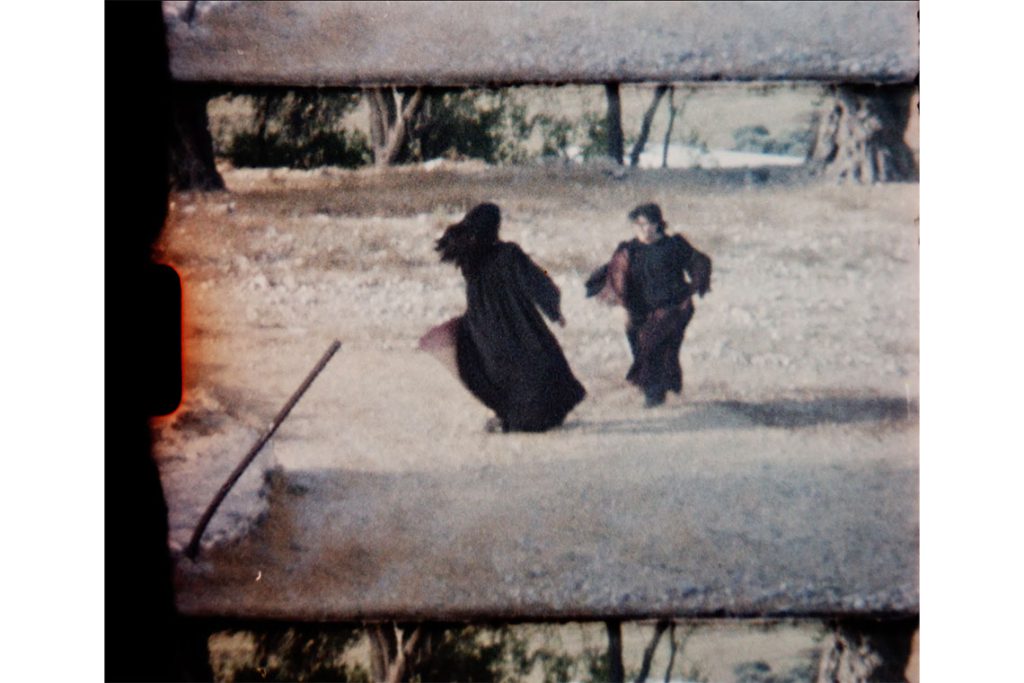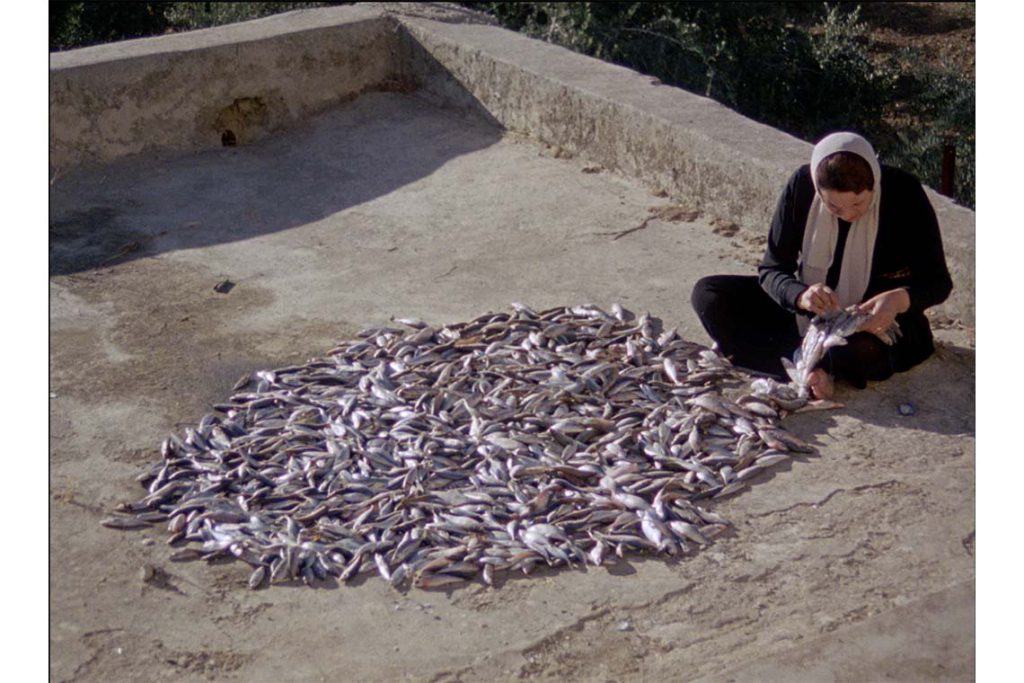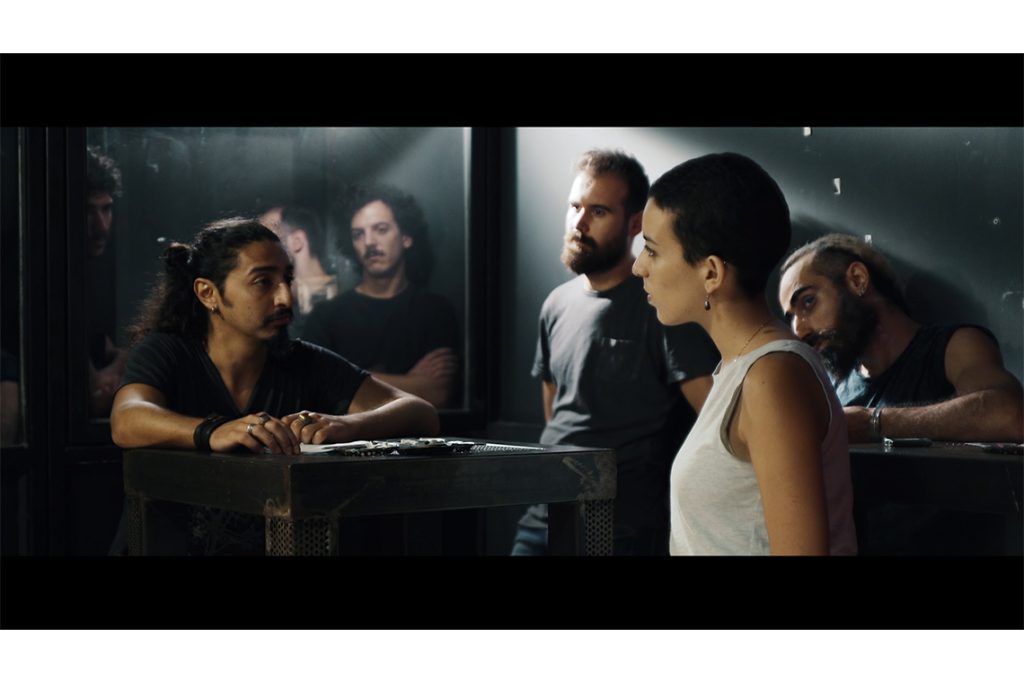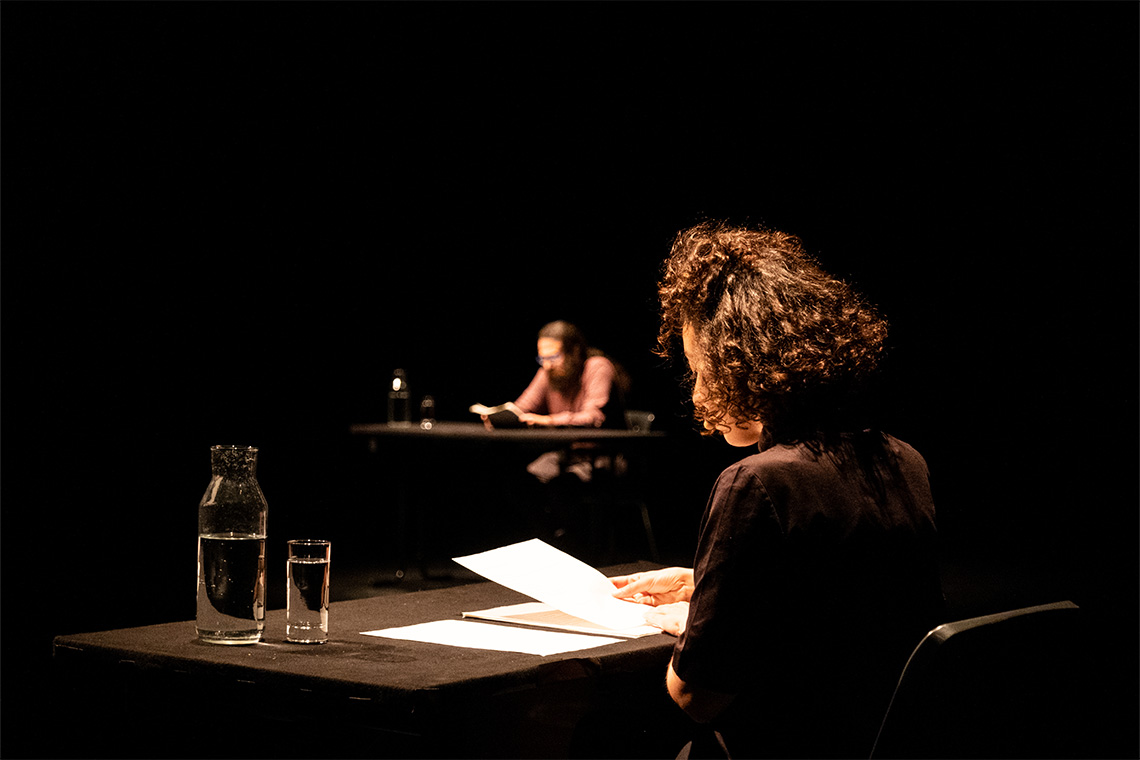Ever watchful and inquisitive, the visual and performance artist draws on older narratives and storylines to fashion her own new commentary on our lives and times. What’s not there in a movement or a glance is just as important as what is.
For the first four minutes of Noor Abed’s latest film, our songs were ready for all wars to come (2021), the screen remains pitch black. Viewers might mistake this for a technical malfunction, were it not for the gentle wailing that drifts slowly into song. When the work was recently installed at Ikon Gallery in Birmingham, UK, the curator Melanie Pocock saw at firsthand how this challenged audiences. “It shows a confidence from Noor as an artist to let silence and the void speak for itself,” she says.
Abed is gaining recognition for an unflinching artistic approach. our songs is a series of vignettes based on death and mourning in which women dressed in black sing, dance and crawl on the steps of a gaping well. Shot in analogue, it has the timeless quality of archival footage. The backdrop of ruins amid a dusty landscape amplifies this effect. Abed says she chose the village, Al-Jib, because “it was so beautiful, so ancient and not yet a tourist attraction. A site that is somehow forgotten.”
It is also not far from where she grew up. Born in 1988 in the suburbs of Jerusalem, Abed found her imagination captured by the local landscape from an early age. “My house is in front of mountains and there was a cemetery, so I see these connections of walking in the mountains and thinking of death all the time,” she explains. “The landscape is like a beautiful monster that you can never map or understand, it swallows you. A lot of my work embraces this idea.”

As a teenager she wrote stories in her spare time and took painting classes at a youth centre. “I used to create a lot of images through writing, which later on I had the chance to produce as actual images,” she says. The opportunities for an arts education were limited locally but, in 2010, Abed enrolled in a Contemporary Visual Arts programme at Palestine’s International Academy of Art, offered in partnership with the Oslo National Academy.
“I was really confronted with different forms of performance,” she recalls. “I was interested in experimenting with the body in the public space.” She wrote a thesis inspired by the German dancer Pina Bausch, but the bigger breakthrough came about accidentally. Invited to perform at a festival in Norway, she installed a bike – literally – on a lake and completed two cycling performances. Soon after, the festival organisations sent her some photographs.
“That was the moment when I realised how important the documentation of something is,” she says. “It opened up a new dimension in my practice. I started studying the angles and the camera.” Abed moved to Los Angeles to start an MFA in Photography and Media at CalArts, where she began seeing her practice as a mix of choreography and cinematography. In particular, she was fascinated by social choreography, which remains central to her practice, and began to explore the relationship between multiple bodies. What is visible? What is unseen? How, through movement, can we create narrations? Reflecting on this ‘politics of movement’ came naturally to her. “Being in Palestine, you have to think about your movements all the time,” she remarks.

On a trip home Abed cast her mother as the protagonist in Penelope (2014), in which she stitches together a mass of dead fish. “I pushed myself to get out from in front of the camera to behind the lens,” she explains. It was also the first time she looked to mythology for inspiration. For her, mythology or folklore is “a collective alternative narration that is not necessarily in the main line of history. Coming from Palestine, there’s a need to create alternative realities.” In this case, her evocation of Penelope from Homer’s Odyssey, who waits faithfully for her husband, was “a criticism of the hero figure that we have in Palestine. We are always longing for a hero.”
Research for projects introduced her to the writings of Serbian performance theorist Bojana Cvejić, Russian filmmaker Andrei Tarkovsky and Brazilian philosopher Paulo Freire. Her growing appetite for new ideas and ideologies was not satisfied by her MFA’s emphasis on practical experimentation so, in 2015, Abed applied for the Whitney Museum’s Independent Study Program in New York. There she read extensively, enthralled in particular by Marxist cultural theory. The broad resonances and varied applications of these texts felt refreshing after the confining experiences she’d had with identity politics in the USA. “It was imposed on me. You’re boxed into only one identity and it always needs to be pointed out that you’re Arab or you’re dark skinned,” Abed recalls. “You need to speak about Palestine all the time. I’m interested in things that open up to all social and political realities. I can also talk about the weather if I want to,” she quips.
In 2016 she moved to Beirut to do the Home Workspace Program at Ashkal Alwan. “I got all this theory, but I really wanted to be on the ground in the region where I work and live,” she explains. “These theories came from the West, but I wanted to find their alternatives in the East.”
By chance, Abed and her friend Mark Lotfy were approached one night at a bar in Beirut by a man called Jerry who told them he was planning to go to Syria to fight ISIS. Working from recordings taken in secret, Abed and Lotfy reconstructed the scene at the same bar in order to tell the story of “the mythological figure of a European saviour who wants to go to the Middle East and liberate the land.”

The resulting film, One Night Stand (2019), is unlike her others, but many of these also have a seemingly predestined yet chance quality to them. “My dreams are very important,” she affirms. “Images need to come to me, or I feel them somehow, and then they need to be produced in another form.”
After her first serendipitous encounter with the village of Al-Jib, she says, “the place kept coming to me in my head and I went again and again.” She began compulsively imagining scenes taking place there and researched its local folktales. Lecturing on Performance Theory and Video Art at the time at Birzeit University, she used her salary to cover the production costs of our songs. What she hoped to capture above all, through the themes of loss and mourning, was “the community aspect of folktales”. Letting her imagination run free, she says, “I created my own community rituals in that site.”
Abed has also sought community outside her art, setting up the School of Intrusions with Lara Khaldi in 2019. The experimental educational platform welcomes participants through registration call and uses the city of Ramallah as a communal space. Meetings are held at various sites where ‘intrusions’ such as readings or performances take place. Working with collectives has become a new form of practice for Abed, who currently resides in Kassel, Germany and is curatorial assistant to 12 collectives preparing for documenta fifteen this summer.
In a new collaboration with Lotfy, Yours Truly, the pair deliver a lecture-performance about the personal and political impacts arising from the use of private American military companies in the Middle East. Abed’s work is always gaining a sharper edge, but she traces the threads of her thoughts to back as early as she can remember. “I think what I do now is still painting somehow,” she suggests, reflecting on her earliest artistic expressions. “There is an image and it’s moving in my head. I want us to see it in reality.”



